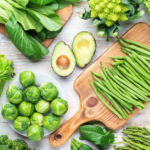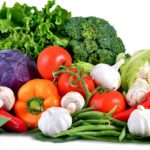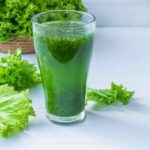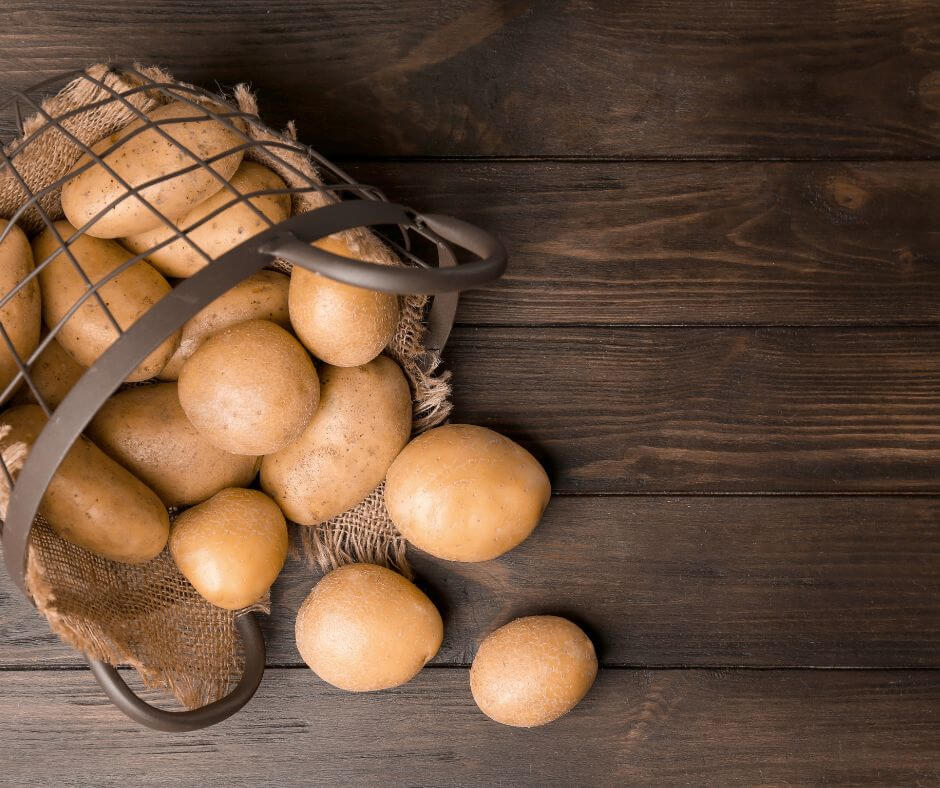Discover the vegetables high in proteins and perfect for plant-based diets. From spinach to broccoli to edamame, learn how to power up your protein intake with these nutrient-packed veggies.
In this blog post, we’ll share the top 10 vegetables high in proteins list and perfect for plant-based diets. As more and more people turn to plant-based diets for health and ethical reasons, it’s important to know which vegetables are high in protein. Contrary to popular belief, it’s possible to get all the protein you need from plants, as long as you know which foods to eat.
Here are 10 Vegetables high in proteins
Spinach:

Here’s a simple and tasty recipe for spinach:
Ingredients:
1 tablespoon of olive oil
2 cloves of garlic, minced
6 cups of fresh spinach leaves
1/2 teaspoon salt
1/4 teaspoon black pepper
Juice of 1/2 lemon
Instructions:
A big skillet with medium heat is used to heat the olive oil.
When aromatic, add the minced garlic and cook for 1-2 minutes.
Add spinach leaves to the skillet and sprinkle with salt and black pepper. Toss the spinach gently to coat it with the oil and seasonings.
Cook for 2–3 minutes until the spinach is wilted and tender, stirring occasionally.
Squeeze the lemon juice over the spinach and stir to combine.
Remove from the heat and serve as a side dish with your favorite main course.
Enjoy your delicious and healthy sautéed spinach!
5 grams of protein per cup
One cup of cooked spinach contains approximately 5 grams of protein. Spinach is a leafy green vegetable that is packed with a variety of important nutrients. It is low in calories and fiber, making it a great choice for those looking to maintain a healthy weight or lose weight. Spinach is also high in antioxidants.
One of the most important nutrients found in spinach is vitamin K. This nutrient is essential for maintaining healthy bones and preventing osteoporosis. Spinach is also high in iron, which is essential for the production of red blood cells and the prevention of anemia. Spinach is a good source of vitamin A, vitamin C, and folate.
One of the best things about spinach is how versatile it is. It can be used in a variety of cuisines, including salads, soups, and stir-fries, and it can be either raw or cooked. Spinach is also a popular ingredient in smoothies and juices, making it an easy way to incorporate more greens into your diet.
Broccoli:

Here’s a simple and tasty recipe for roasted broccoli:
Ingredients:
1 head of broccoli, chopped into bite-size florets
2 tablespoons of olive oil
1/2 teaspoon salt
1/4 teaspoon black pepper
1/4 teaspoon garlic powder
1/4 teaspoon onion powder
Instructions:
Preheat the oven to 425°F (218°C).
In a large mixing bowl, combine the broccoli florets, olive oil, salt, black pepper, garlic powder, and onion powder. Toss well to coat the broccoli completely.
Transfer the broccoli to a baking sheet in a single layer, making sure not to overcrowd the pan.
Roast for 15-20 minutes, or until the broccoli is tender and lightly browned, stirring once halfway through cooking.
Remove from the oven and let cool for a few minutes before serving as a side dish.
Enjoy your delicious and healthy roasted broccoli!
3 g of protein per cup
One cup of chopped broccoli (cooked, boiled, or steamed) contains approximately 3 grams of protein. A cruciferous vegetable with a long list of health advantages is broccoli. It is low in calories and fiber, making it an excellent choice for those looking to maintain a healthy weight or lose weight.
The most important nutrient found in broccoli is vitamin C. This nutrient is essential for maintaining a healthy immune system and is also important for the production of collagen, which helps keep skin and other tissues healthy. Broccoli is also high in vitamin K, which is essential for maintaining healthy bones.
A versatile vegetable, broccoli can be consumed both fresh and cooked. It can be roasted, steamed, stir-fried, or added to soups and stews. It can also be eaten as a snack with hummus or other dips. Broccoli is a popular ingredient in many dishes, such as pasta dishes, casseroles, and salads.
Edamame:

Here’s a simple and tasty recipe for garlic edamame:
Ingredients:
1 pound of frozen edamame in pods
1 tablespoon of olive oil
2-3 cloves of garlic, minced
1/2 teaspoon salt
1/4 teaspoon black pepper
Juice of 1/2 lemon
Instructions:
Cook the edamame according to the package directions.
Olive oil should be heated in a big skillet over medium heat.
When aromatic, add the minced garlic and cook for 1-2 minutes.
Add the cooked edamame to the skillet and toss to coat with the garlic and oil.
Sprinkle with salt and black pepper and stir to combine.
Squeeze the lemon juice over the edamame and stir gently to evenly distribute the seasoning.
Remove from heat and serve hot as a delicious and healthy snack or side dish.
Enjoy your garlic edamame!
18–20 g of protein per cup
Yes, one cup of cooked edamame typically contains around 18–20 grams of protein, making it a great source of plant-based protein. It is a popular soybean snack that is packed with a variety of important nutrients. It is low in calories and protein and fiber, making it a great choice for those looking to maintain a healthy weight.
One of the most important nutrients found in edamame is protein. It has all nine of the essential amino acids that the body needs, making it a complete protein. This makes edamame an excellent source of plant-based protein.
Edamame is typically served as a snack, often in Japanese cuisine. It can be boiled or steamed and is usually served in the pod with a sprinkle of salt. Edamame can also be added to salads, stir-fries, and soups for a boost of protein and texture.
Brussels Sprouts:

Here’s a simple and tasty recipe for roasted Brussels sprouts:
Ingredients:
1 pound Brussels sprouts, trimmed and halved
2 tablespoons of olive oil
1/2 teaspoon salt
1/4 teaspoon black pepper
1/4 teaspoon garlic powder
1/4 teaspoon onion powder
Instructions:
Preheat the oven to 425°F (218°C).
In a large mixing bowl, combine the Brussels sprouts, olive oil, salt, black pepper, garlic powder, and onion powder. Toss well to evenly coat the Brussels sprouts.
Transfer the Brussels sprouts to a baking sheet in a single layer, making sure not to overcrowd the pan.
Roast for 20–25 minutes, or until the Brussels sprouts are tender and lightly browned, stirring once halfway through cooking.
Remove from the oven and let cool for a few minutes before serving as a side dish.
Enjoy your delicious and healthy roasted Brussels sprouts!
3 g of protein per cup
One cup of cooked Brussels sprouts contains approximately 3 grams of protein. Brussels sprouts are a cruciferous vegetable that looks like miniature cabbages. They are packed with a variety of important nutrients and health benefits. It is low in calories and fiber, making it an excellent option for those trying to reduce weight.
An important nutrient found in Brussels sprouts is vitamin K. This nutrient is essential for maintaining healthy bones and preventing osteoporosis. Brussels sprouts are also high in vitamin C, which is essential for maintaining a healthy immune system and is also important for the production of collagen, which helps keep skin healthy.
Brussels sprouts can be eaten raw or cooked and can be roasted, sautéed, or steamed. They can be added to salads, soups, and stir-fries, among other foods. Brussels sprouts are also a popular side dish and can be seasoned with herbs.
Cauliflower:

Here’s a simple and tasty recipe for roasted cauliflower:
Ingredients:
1 head of cauliflower
2 tablespoons of olive oil
1 teaspoon salt
1/2 teaspoon black pepper
1/2 teaspoon garlic powder
1/2 teaspoon onion powder
1/4 teaspoon paprika
Instructions:
Preheat the oven to 425°F (218°C).
Cut the cauliflower into bite-sized florets after washing it.
In a large bowl, combine the olive oil, salt, black pepper, garlic powder, onion powder, and paprika.
Add the cauliflower florets to the bowl and toss until they are well coated in the spice mixture.
On a baking sheet, spread the cauliflower out in a single layer.
Roast the cauliflower in the preheated oven for 25–30 minutes, or until it is tender and golden brown on the outside.
Serve the roasted cauliflower hot as a side dish or a snack.
Enjoy your delicious and healthy roasted cauliflower!
2 g of protein per cup
One cup of cooked cauliflower contains approximately 2 grams of protein. It is low in calories and fiber, making it an excellent choice for those looking to maintain a healthy weight or lose weight. Cauliflower is also high in antioxidants, which can help reduce the risk of chronic diseases such as heart disease, cancer, and diabetes.
One of the most important nutrients found in cauliflower is vitamin C. This nutrient is essential for maintaining a healthy immune system and is also important for the production of collagen, which helps keep skin and other tissues healthy.
A versatile vegetable, cauliflower can be consumed both raw and cooked. It can be roasted, steamed, stir-fried, or added to soups and stews. It can also be used as a substitute for rice or mashed potatoes in many dishes, making it a great low-carb option. Cauliflower is a popular ingredient in many dishes.
Artichokes:

Here’s a simple and tasty recipe for steamed artichokes:
Ingredients:
2 whole artichokes
2 cloves of garlic, minced
2 tablespoons of olive oil
1/2 teaspoon salt
1/4 teaspoon black pepper
1/2 lemon, cut into wedges
Instructions:
Rinse the artichokes under cold water and trim the stem and the tops of the leaves.
Cut off the top 1/2 inch of the artichoke and trim the sharp tips off the remaining leaves.
Fill a large pot with 2-3 inches of water and bring it to a boil.
Add the garlic, olive oil, salt, and black pepper to the pot.
Artichokes should be placed stem-side down in the pot.
Cover the pot and steam the artichokes for 25–35 minutes, or until the leaves are tender and can be easily pulled off.
After removing the artichokes from the pot, give them some time to cool.
Serve the artichokes with lemon wedges on the side.
You can also dip the leaves in melted butter or mayonnaise for extra flavor. Enjoy your steamed artichokes!
4 grams of protein per cup
One medium artichoke contains approximately 4 grams of protein. Artichokes are a delicious and nutritious vegetable that is native to the Mediterranean region. They are low in calories and fiber, making them an excellent choice for those looking to maintain a healthy weight or lose weight.
An important nutrient found in artichokes is fiber. It is an excellent source of both soluble and insoluble fiber, which can help improve digestion, reduce inflammation, and promote overall gut health. It is also a good source of vitamin C, which helps maintain a healthy immune system, and folate, which is important during pregnancy.
Artichokes can be enjoyed in a variety of ways, such as steamed, boiled, grilled, or roasted. They can also be stuffed with a variety of fillings, such as breadcrumbs, cheese, or herbs, making them versatile ingredients for many dishes.
Asparagus:

Here’s a simple and tasty recipe for roasted asparagus:
Ingredients:
1 bunch of asparagus, trimmed
2 tablespoons of olive oil
1/2 teaspoon salt
1/4 teaspoon black pepper
1/2 lemon, cut into wedges
Instructions:
Preheat the oven to 425°F (218°C).
Trim the rough ends from the asparagus after giving it a cold water rinse.
Sprinkle olive oil over the asparagus before placing it on a baking sheet.
Sprinkle with salt and black pepper and toss in the coat.
Roast the asparagus in the preheated oven for 10–15 minutes, or until it is tender and lightly browned.
Just before serving, squeeze some fresh lemon juice over the asparagus.
You can also add grated Parmesan cheese, chopped garlic, or lemon zest to the asparagus before roasting for extra flavor. Enjoy your delicious roasted asparagus!
4 grams of protein per cup
One cup of cooked asparagus contains approximately 3 grams of protein. Asparagus, a vegetable rich in vitamins, minerals, and antioxidants, is also nutrient-dense. It is low in calories and fiber, making it an excellent choice for those looking to maintain a healthy weight or lose weight.
The most important nutrient found in asparagus is folate. Folate is essential for proper brain function and can help reduce the risk of birth defects during pregnancy.
Asparagus is also high in vitamin K, which is important for maintaining healthy bones and preventing osteoporosis. Additionally, asparagus is a good source of antioxidants such as vitamin C, beta-carotene, and lutein, which can help protect against chronic diseases such as cancer and heart disease.
Asparagus can be prepared in a variety of ways, such as roasted, grilled, steamed, or boiled. It can be enjoyed as a side dish or incorporated into a variety of recipes, such as salads, soups, and pasta dishes. Asparagus is also a great addition to omelets or quiches and can be wrapped in prosciutto or bacon for a tasty appetizer.
Peas:

Here’s a simple recipe for a classic side dish, buttered peas:
Ingredients:
2 cups frozen peas
2 tablespoons unsalted butter
1/2 teaspoon salt
1/4 teaspoon black pepper
Instructions:
Boil some salted water in a pot.
Add the frozen peas to the pot and cook for 2-3 minutes, or until they are tender.
Add the butter, salt, and black pepper to the pot.
Heat the peas and butter over low heat, stirring occasionally, until the butter is melted and the peas are coated in the butter sauce.
Serve the buttered peas hot as a side dish.
You can also add chopped fresh herbs, such as parsley, mint, or basil, to the buttered peas for extra flavor. Enjoy your delicious and easy buttered peas!
8 grams of protein per cup
Green peas are a type of legume that is commonly consumed as a vegetable. They are a good source of plant-based protein, as one cup of cooked green peas contains approximately 8 grams of protein.
Peas are versatile and nutritious vegetables that are popular all over the world. They are packed with essential vitamins, minerals, and antioxidants that can help keep your body healthy and functioning properly. Peas are also low in calories and high in fiber, making them an excellent addition to any diet.
The most important nutrient found in peas is vitamin C. This powerful antioxidant can help boost the immune system, improve skin, and reduce the risk of chronic diseases. Peas are also a good source of vitamin K, which is important for maintaining healthy bones, as well as folate, which is essential for proper brain function.
Peas are also a great source of plant-based protein, containing approximately 5-7 grams of protein per cup. This makes them an excellent choice for vegetarians and vegans looking to increase their protein intake. Peas are also a good source of iron and other essential minerals such as magnesium, potassium, and zinc.
Peas can be enjoyed in a variety of ways, such as steamed, boiled, roasted, or mashed. They can be used as an ingredient in a variety of dishes, such as soups, stews, casseroles, and salads. Peas are also a great addition to pasta dishes.
Sweet Potatoes:

Here’s a simple and tasty recipe for roasted sweet potato wedges:
Ingredients:
2 medium sweet potatoes, peeled and cut into wedges
2 tablespoons of olive oil
1/2 teaspoon salt
1/4 teaspoon black pepper
1/2 teaspoon garlic powder
1/2 teaspoon paprika
Instructions:
Preheat the oven to 425°F (218°C).
In a large bowl, combine the sweet potato wedges, olive oil, salt, black pepper, garlic powder, and paprika.
Toss the sweet potato wedges until they are well coated in the spice mixture.
Spread the sweet potato wedges out in a single layer on a baking sheet.
Roast the sweet potato wedges in the preheated oven for 20–25 minutes, or until they are tender and lightly browned.
Serve the roasted sweet potato wedges hot as a side dish or a snack.
You can also sprinkle chopped fresh herbs, such as rosemary or thyme, over the sweet potato wedges before roasting for extra flavor. Enjoy your delicious and healthy roasted sweet potato wedges!
4 grams of protein
One medium-sized sweet potato contains approximately 4 grams of protein. Sweet potatoes are a delicious and nutritious vegetable that is enjoyed all over the world. They are packed with essential vitamins and minerals, as well as dietary fiber, making them a healthy addition to any diet.
One of the most important nutrients found in sweet potatoes is beta-carotene, which is a precursor to vitamin A. Beta-carotene is a powerful antioxidant that can help protect the body from free radicals, which can cause damage to cells and contribute to the development of chronic diseases.
Sweet potatoes are also a great source of dietary fiber, containing approximately 3–4 grams of fiber per medium-sized potato. Maintaining digestive health, controlling blood sugar levels, and lowering the risk of heart disease all depend on fiber.
Sweet potatoes can be enjoyed in a variety of ways, such as roasted, baked, boiled, or mashed. They can be used as an ingredient in a variety of dishes, such as soups, stews, casseroles, and pies. Sweet potatoes can also be used as a healthier alternative to regular potatoes in many dishes.
Kale:

Here’s a simple and tasty recipe for a kale salad:
Ingredients:
1 bunch of kale, stems removed and leaves chopped
1/4 cup olive oil
1/4 cup fresh lemon juice
1 garlic clove, minced
1/2 teaspoon salt
1/4 teaspoon black pepper
1/4 cup grated Parmesan cheese
1/4 cup chopped walnuts
Instructions:
In a large bowl, combine the chopped kale, olive oil, lemon juice, garlic, salt, and black pepper.
Use your hands to massage the kale leaves for 2-3 minutes, or until they are tender and wilted.
Add the grated Parmesan cheese and chopped walnuts to the bowl and toss to combine.
Serve the kale salad immediately.
You can also add other vegetables or fruits to the kale salad, such as cherry tomatoes, avocados, or apples, for extra flavor and nutrition. Enjoy your delicious and healthy kale salad!
3 g of protein per cup
One cup of chopped kale contains approximately 3 grams of protein. Kale is a leafy green vegetable that has become increasingly popular in recent years due to its high nutrient content and health benefits. It is a member of the cruciferous family, which has nutrient-dense vegetables such as broccoli, cauliflower, and Brussels sprouts.
An important nutrient found in it is vitamin K, which is essential for healthy bones and proper blood clotting. Kale is also a good source of vitamin C, which is important for immune system function, as well as antioxidants such as beta-carotene and lutein, which can help protect the body from the harm that free radicals can do.
Kale is also a great source of dietary fiber, containing approximately 2–3 grams of fiber per cup. Maintaining digestive health, controlling blood sugar levels, and lowering the risk of heart disease all depend on fiber.
Kale can be enjoyed in a variety of ways, such as steamed, sautéed, roasted, or raw in salads. It can also be used as an ingredient in a variety of dishes, such as soups, stews, casseroles, and smoothies. Kale is a versatile vegetable that pairs well with a variety of other ingredients, making it an easy addition to any meal.














One thought on “Read about 10 Vegetables high in proteins list”